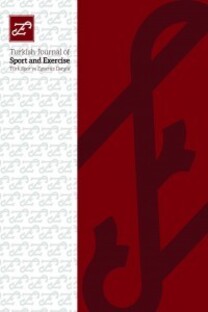Comparison of anaerobic power and vertical jump measurements of taekwondo and karate athletes
Comparison of anaerobic power and vertical jump measurements of taekwondo and karate athletes
___
- Açıkada C. Ergen E. Bilim ve Spor. Büro–Tek Ofset Matbaacılık. Ankara, 1990.
- Ara I, Vicente-Rodríguez G, Jimenez-Ramirez J, et al. Regular Participation in Sports is Associated with Enhanced Physical Fitness and Lower Fat Mass in Prepubertal Boys. International Journal of Obesity and Related Metabolic Disorders. 2004; 28(12):1585-1593.
- Aydos L. Kürkçü R. 13-18 Yaş Grubu Spor Yapan ve Yapmayan Orta Öğrenim Gençliğinin Fiziksel ve Fizyolojik Özelliklerinin Karşılaştırılması. G.Ü. Beden Eğitimi ve Spor Bilimleri Dergisi, 1997; 2(2):31-38.
- Christou M, Smilios I, Sotiropoulos K, et al. Effects of Resistance Training on thePhysicalCapacities of Adolescent Soccer Players. Journal of StrengthandConditioningResearch, 2006;20(4):783-791. Çelenk Ç, Çumralıgil B. Takım Sporcuları İle Ferdi Sporcuların Bazı Fiziksel Ve Fizyolojik Özelliklerinin Karşılaştırılması. Journal of Physical Education and Sport Sciences, 2005; 7(3):1-7.
- Çimen O, Cicioğlu İ, Günay M. Erkek ve Bayan Türk Genç Milli Masa Tenisçilerin Fiziksel ve Fizyolojik Profilleri. G.Ü. Beden Eğitimi ve Spor Bilimleri Dergisi, 1997; 2(4):7-12.
- Jonathan M, Euan A. A perspective on exercise, lactate, andtheanaerobicthreshold. Chest, 1997: 111;787-795.
- Kazemi M, Perri G, Soave D. A profile of 2008 Olympic Taekwondo competitors. J Can ChiroprAssoc, 2010;54(4):243-249.
- Kuter M. ve Öztürk F. Türkiye Şampiyonu Bir Küçük Yıldız Basketbol Takımının Fiziksel ve Fizyolojik Profilinin Dereceye Girememiş Bir Takım ile Karşılaştırılması. Spor Bilimleri II. Ulusal Kongresi Bildirileri. Spor Bilimleri ve Teknolojisi Yüksekokulu Yayını, 1992; 3:265-271. Ankara.
- Li L., Li K. andUshijima H. Moderate-vigorousphysicalactivityand body fatness in Chinese urban schoolchildren. Pediatr Int. 2007; 49(2):280-285
- Melhim AF. Aerobic and anaerobic power responses to the practice of taekwon-do. Br J Sports Med, 2001;35:231-235.
- H Muratlı S. Çocuk ve Spor. Bağırgan Yayınevi, Ankara, 1997.
- Müniroğlu S., Şen P. ve Tanılkan K. Ankara’daki 12- 14 Yaş Grubu Kız Erkek Uzun Ve Kısa Mesafe Yüzücülerin Dikey Sıçrama Derecelerinin İncelenmesi. M.Ü. Spor Araştırmaları Dergisi, 2000; 4(1):21-32.
- Pesic S, Jakovljevic V, Djordjevic D, Cubrilo D, Zivkovic V, Jorga V, Mujovic V, Djuric D, Stojimirovic B. Exercise-induced changes in redox status of elite karate athletes. Chin J Physiol, 2012; 29;55(1):8-15.
- Yıldız SA. AerobikveAnaerobikKapasiteninAnlamıNedir? Solunum, 2012; 14:1–8.
- Zorba E, Kalkavan A, Ağaoğlu S, Karakuş S, Çolak H. Farklı Spor Branşlarında Bazı Fiziksel Uygunluk Değerlerinin Sedanter Grupla Karşılaştırılması. G.Ü. Beden Eğitimi ve Spor Bilimleri Dergisi, 1996; 1(3):25-35.
- Yayın Aralığı: 3
- Başlangıç: 1999
- Yayıncı: Selçuk Üniversitesi, Spor Bilimleri Fakültesi
Zekihan HAZAR, Ercan POLAT, Serkan HAZAR
Harun GENÇ, Gökmen KILNÇARSLAN, İdris KAYANTAŞ, Akan BAYRAKTAR
Ahmet ÇÖNDÜ, Orhan Ahmet ŞENER, Şerife ALPA
İbrahim BOZKURT, Mehibe AKANDERE, Gaye ERKMEN, Elif Aycan ATAK
Necmi GÜRSAKAL, Fırat Melih YILMAZ, Halil Orbay ÇOBANOĞLU, Sandy ÇAĞLIYOR
